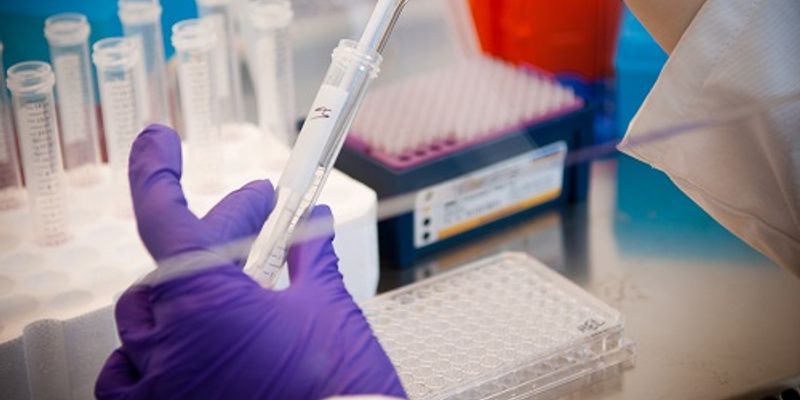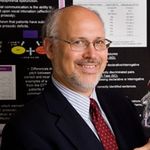Clinical Biochemistry
Clinical Biochemistry: Clinical chemistry (also known as chemical pathology, clinical biochemistry or medical biochemistry) is the area of chemistry that is generally concerned with the analysis of bodily fluids for diagnostic and therapeutic purposes.
-
APR 06, 2016 | 1:30 PMDetection of mutational alterations is important for guiding treatment decisions of lung non-small cell carcinomas and thyroid nodules with atypical cytologic findings. Inoperable lung tumors...Speaker: Maja Oktay, MD, PhD , Sumanta Goswami, PhDPresented at: Molecular Diagnostics Virtual Event Series 2016
MAR 17, 2016 | 1:30 PMMaturing neural circuits are dramatically shaped by the environment, but this timing varies across brain regions and plasticity declines with age. Focusing on cellular/molecular mechanisms un...MAR 17, 2016 | 12:00 PMSchizophrenia, depression, bipolar disorder are all uniquely human conditions. Psychiatric conditions include alterations in several different and overlapping domains (NIMH RDoC). Each...MAR 17, 2016 | 10:30 AMGiven the challenges of replicating Parkinson’s disease in animal models, returning to models that are human-based and highly clinically characterized may provide the most successful pa...MAR 17, 2016 | 10:30 AMThe adolescent brain has been forged by evolution to have different features than those of a child or an adult, but it is not broken or defective. Phenomenal ability to adapt to environ...MAR 17, 2016 | 9:00 AMA key goal in psychiatry is to build new diagnostic, therapeutic and translational tools and capacity to reduce the impact of emerging mental disorders in young people on survival, distress,...Speaker: Patrick McGorry, MD, PhD, FRCP, FRANZCPPresented at: Neuroscience Virtual Event Series 2016
MAR 17, 2016 | 9:00 AMDrug addiction is a chronically relapsing disorder characterized by compulsive drug use despite catastrophic personal consequences (e.g., loss of family, job) and even when the substance is n...MAR 17, 2016 | 7:30 AMThere is a growing appreciation of the relationship between gut microbiota, and the host in maintaining homeostasis in health and predisposing to disease. Bacterial colonisation of the gut pl...MAR 17, 2016 | 7:30 AMSchizophrenia (Sz) is a major mental disorder that affects ~1% of the population. Although traditional models of Sz focused on dopaminergic dysfunction, newer models increasingly implic...MAR 17, 2016 | 6:00 AMIn this presentation, Arvid Carlsson, who was awarded the Nobel prize in 2000 for his discovery of the transmitter role of dopamine, will be interviewed by Elias Eriksson. The following aspec...MAR 16, 2016 | 1:30 PMImpulse control disorders (ICDs), also known as behavioural addictions, are common in the general population and can have marked consequences. ICDs can also commonly occur with exposure...MAR 16, 2016 | 12:00 PMThis talk will provide an overview of Fourier Transform InfraRed (FTIR) chemical imaging as a powerful and versatile method for obtaining information about CNS tissues. By combining imaging a...MAR 16, 2016 | 12:00 PMTraditional models of basal ganglia disorders are grounded in the assumption that network dysfunction is driven by alterations in intrinsic excitability of striatal neurons. Recent work has c...MAR 16, 2016 | 10:30 AMInnovation in Psychopharmacology is Dead. Long Live Innovation in Psychopharmacology! What’s going on in our field? Priorities of Big Pharma shifting away fr...MAR 16, 2016 | 10:30 AMIn the adult central nervous system (CNS) small populations of neurons are formed in the adult olfactory bulb and dentate gyrus of the hippocampus. In the adult hippocampus, newly born neuron...MAR 16, 2016 | 9:00 AMWe routinely face decisions requiring evaluation and choice of different actions may or may not yield different types of rewards. These situations trigger competitive decision biases that ref...MAR 16, 2016 | 7:30 AMOptogenetics or optophysiology is a rapidly growing technique used across an ever broadening array of research fields. Investigators now genetically modify many signalling pathway elements to...MAR 16, 2016 | 6:00 AMOur goal - To Understand the Neurobiology of Emotions and Affect and Its Relevance to Psychiatric Disorders. This includes: Understanding basic mechanisms of affect, stre...FEB 24, 2016 | 3:00 PMThe greatest health epidemic of our time is cancer. Deaths from cancer worldwide outnumber the combined deaths from HIV/AIDS, tuberculosis and malaria by a wide margin. There are at least 100...FEB 24, 2016 | 2:00 PMA century and a half after we first probed heritability, we risk forgetting one of Mendel's own basic findings, in rushing to broaden clinical genomics to lifelong care for all. Embracing...FEB 24, 2016 | 1:00 PMWhile next-generation sequencing has proven to be a very useful tool in basic research, two major hurdles remain for its broad adoption in the clinical research setting: lack of seamless work...FEB 24, 2016 | 1:00 PMPrecision medicine requires understanding the mechanistic basis of complex disorders, and to precisely manipulate these mechanisms to better human health. This is partly enabled by the recent...FEB 24, 2016 | 12:00 PMThe advent of the microarray technology in 2000 has paved the way for advanced translational research methods that use molecular markers such as microRNA, proteins, metabolites and copy numbe...FEB 24, 2016 | 11:00 AMCell death is involved in diseases such as cancer and neurodegeneration, and also has a natural role in the development of multicellular organisms. Although apoptosis has been well defined, a...
APR 06, 2016 | 1:30 PM
Detection of mutational alterations is important for guiding treatment decisions of lung non-small cell carcinomas and thyroid nodules with atypical cytologic findings. Inoperable lung tumors...
Speaker:
Maja Oktay, MD, PhD
, Sumanta Goswami, PhD
Presented at: Molecular Diagnostics Virtual Event Series 2016
MAR 17, 2016 | 1:30 PM
Maturing neural circuits are dramatically shaped by the environment, but this timing varies across brain regions and plasticity declines with age. Focusing on cellular/molecular mechanisms un...
MAR 17, 2016 | 12:00 PM
Schizophrenia, depression, bipolar disorder are all uniquely human conditions. Psychiatric conditions include alterations in several different and overlapping domains (NIMH RDoC). Each...
MAR 17, 2016 | 10:30 AM
Given the challenges of replicating Parkinson’s disease in animal models, returning to models that are human-based and highly clinically characterized may provide the most successful pa...
MAR 17, 2016 | 10:30 AM
The adolescent brain has been forged by evolution to have different features than those of a child or an adult, but it is not broken or defective. Phenomenal ability to adapt to environ...
MAR 17, 2016 | 9:00 AM
A key goal in psychiatry is to build new diagnostic, therapeutic and translational tools and capacity to reduce the impact of emerging mental disorders in young people on survival, distress,...
Speaker:
Patrick McGorry, MD, PhD, FRCP, FRANZCP
Presented at: Neuroscience Virtual Event Series 2016
MAR 17, 2016 | 9:00 AM
Drug addiction is a chronically relapsing disorder characterized by compulsive drug use despite catastrophic personal consequences (e.g., loss of family, job) and even when the substance is n...
MAR 17, 2016 | 7:30 AM
There is a growing appreciation of the relationship between gut microbiota, and the host in maintaining homeostasis in health and predisposing to disease. Bacterial colonisation of the gut pl...
MAR 17, 2016 | 7:30 AM
Schizophrenia (Sz) is a major mental disorder that affects ~1% of the population. Although traditional models of Sz focused on dopaminergic dysfunction, newer models increasingly implic...
MAR 17, 2016 | 6:00 AM
In this presentation, Arvid Carlsson, who was awarded the Nobel prize in 2000 for his discovery of the transmitter role of dopamine, will be interviewed by Elias Eriksson. The following aspec...
MAR 16, 2016 | 1:30 PM
Impulse control disorders (ICDs), also known as behavioural addictions, are common in the general population and can have marked consequences. ICDs can also commonly occur with exposure...
MAR 16, 2016 | 12:00 PM
This talk will provide an overview of Fourier Transform InfraRed (FTIR) chemical imaging as a powerful and versatile method for obtaining information about CNS tissues. By combining imaging a...
MAR 16, 2016 | 12:00 PM
Traditional models of basal ganglia disorders are grounded in the assumption that network dysfunction is driven by alterations in intrinsic excitability of striatal neurons. Recent work has c...
MAR 16, 2016 | 10:30 AM
Innovation in Psychopharmacology is Dead. Long Live Innovation in Psychopharmacology! What’s going on in our field? Priorities of Big Pharma shifting away fr...
MAR 16, 2016 | 10:30 AM
In the adult central nervous system (CNS) small populations of neurons are formed in the adult olfactory bulb and dentate gyrus of the hippocampus. In the adult hippocampus, newly born neuron...
MAR 16, 2016 | 9:00 AM
We routinely face decisions requiring evaluation and choice of different actions may or may not yield different types of rewards. These situations trigger competitive decision biases that ref...
MAR 16, 2016 | 7:30 AM
Optogenetics or optophysiology is a rapidly growing technique used across an ever broadening array of research fields. Investigators now genetically modify many signalling pathway elements to...
MAR 16, 2016 | 6:00 AM
Our goal - To Understand the Neurobiology of Emotions and Affect and Its Relevance to Psychiatric Disorders. This includes: Understanding basic mechanisms of affect, stre...
FEB 24, 2016 | 3:00 PM
The greatest health epidemic of our time is cancer. Deaths from cancer worldwide outnumber the combined deaths from HIV/AIDS, tuberculosis and malaria by a wide margin. There are at least 100...
FEB 24, 2016 | 2:00 PM
A century and a half after we first probed heritability, we risk forgetting one of Mendel's own basic findings, in rushing to broaden clinical genomics to lifelong care for all. Embracing...
FEB 24, 2016 | 1:00 PM
While next-generation sequencing has proven to be a very useful tool in basic research, two major hurdles remain for its broad adoption in the clinical research setting: lack of seamless work...
FEB 24, 2016 | 1:00 PM
Precision medicine requires understanding the mechanistic basis of complex disorders, and to precisely manipulate these mechanisms to better human health. This is partly enabled by the recent...
FEB 24, 2016 | 12:00 PM
The advent of the microarray technology in 2000 has paved the way for advanced translational research methods that use molecular markers such as microRNA, proteins, metabolites and copy numbe...
FEB 24, 2016 | 11:00 AM
Cell death is involved in diseases such as cancer and neurodegeneration, and also has a natural role in the development of multicellular organisms. Although apoptosis has been well defined, a...
























